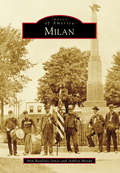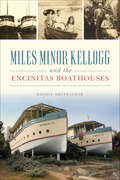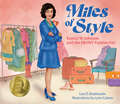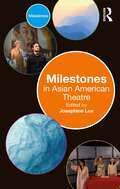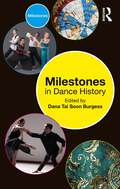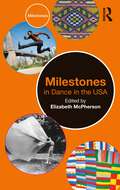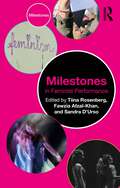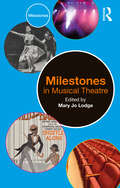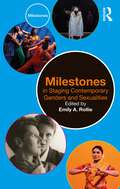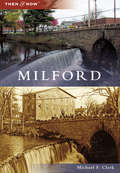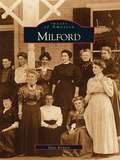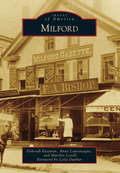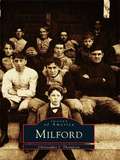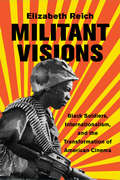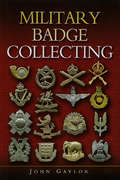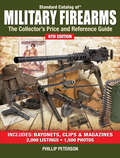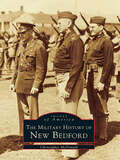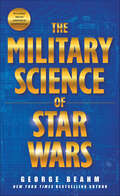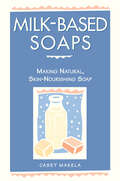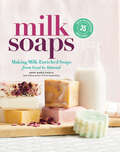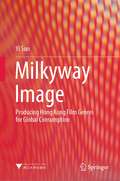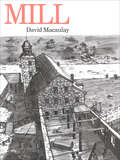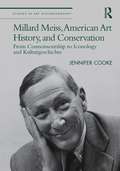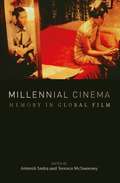- Table View
- List View
Milan (Images of America)
by Ashley Moran Ann Basilone-JonesMilan is located in an area of land known as the Fire Lands, just south of Lake Erie. The first settlement, a Moravian mission called New Salem, did not last long, and permanent settlement came with Ebenezer Merry in 1816. Within 20 years, the citizens of Milan were planning a project that would change the face of the village forever. A group of businessmen banded together and formed the Milan Canal Company, eventually being incorporated by the State of Ohio to help fund the Milan Canal. The economic success that the canal brought resulted in a surge of architecture and wealth in the area. Samuel Edison, a shingle-maker by trade, brought his family here from Canada to gain a piece of the prosperity. During the peak year of 1847, Thomas Alva Edison was born in his home in Milan, where the family remained for seven years.
Miles Minor Kellogg and the Encinitas Boathouses (Landmarks)
by Rachel BrupbacherBuilt in 1929, the Boathouses of Encinitas have captured the attention of locals and tourists alike for decades. Their architect, Miles Minor Kellogg, shared the creative flair and religious fervor of his distant cousin Dr. John Harvey Kellogg and had a passion for invention, music and poetry. A talented carpenter, Miles built his first house at seventeen and worked his way cross-country until settling with his family in the growing town of Encinitas. His construction company, Kellogg and Son, helped transform the landscape, and the unique bungalows were the culmination of his dream to build a boat. Join author Rachel Brupbacher as she traces the steps of her ancestor and one of San Diego County's most innovative architects.
Miles of Style: Eunice W. Johnson and the EBONY Fashion Fair
by Lisa D. BrathwaiteA chic biography about Eunice W. Johnson who brought elegant and contemporary fashion to Black America through the annual EBONY Fashion Fair!Eunice W. Johnson believed in the power of fashion and beauty to inspire people. After she and her husband, John H. Johnson, founded EBONY magazine, it quickly became the premiere lifestyle publication for mid-century Black readers. Among the many hats she wore, Eunice delighted in writing a fashion column describing the latest styles. In 1958, Eunice launched a project that would change fashion forever--the EBONY Fashion Fair. In towns and cities across the United States, Black models walked the runway in the freshest trends that season and Black attendees got to see people who looked like them in bright colors and haute couture. To make the Fashion Fair happen every year, Eunice negotiated with snobby fashion houses in Europe and navigated racism back home in the US, to acquire the most show-stopping styles for her show. Decades later, her name remains a watchword for glamour and elegance in the Black community. Winner of Lee & Low's New Voices award, Miles of Style celebrates a visionary who used her influence to showcase the strength and beauty of the Black community.
Milestones in Asian American Theatre (Milestones)
by Josephine LeeThis introduction to Asian American theatre charts ten of the most pivotal moments in the history of the Asian diaspora in the USA and how those moments have been reflected in theatre. Designed for weekly use on Asian American theatre courses, ten chosen milestones move chronologically from the earliest contact between Japan and the West through the impact of the Vietnam War and the resurgent "yellow peril" hysteria of COVID-19. Each chapter emphasizes common questions of how racial identities and relationships are understood in everyday life as well as represented on the theatrical stage and in popular culture. Milestones are a range of accessible textbooks, breaking down the need-to-know moments in the social, cultural, political, and artistic development of foundational subject areas.
Milestones in Dance History (Milestones)
by Dana Tai Soon BurgessThis introduction to world dance charts the diverse histories and stories of dancers and artists through ten key moments that have shaped the vast spectrum of different forms and genres that we see today. Designed for weekly use in dance history courses, ten chosen milestones move chronologically from the earliest indigenous rituals and the dance crazes of Eastern trade routes, to the social justice performance and evolving online platforms of modern times. This clear, dynamic framework uses the idea of migrations to chart the shifting currents of influence and innovation in dance from an inclusive set of perspectives that acknowledge the enduring cultural legacies on display in every dance form. Milestones are a range of accessible textbooks, breaking down the need-to-know moments in the social, cultural, political, and artistic development of foundational subject areas.
Milestones in Dance in the USA (Milestones)
by Elizabeth McPhersonEmbracing dramatic similarities, glaring disjunctions, and striking innovations, this book explores the history and context of dance on the land we know today as the United States of America. Designed for weekly use in dance history courses, it traces dance in the USA as it broke traditional forms, crossed genres, provoked social and political change, and drove cultural exchange and collision. The authors put a particular focus on those whose voices have been silenced, unacknowledged, and/or uncredited – exploring racial prejudice and injustice, intersectional feminism, protest movements, and economic conditions, as well as demonstrating how socio-political issues and movements affect and are affected by dance. In looking at concert dance, vernacular dance, ritual dance, and the convergence of these forms, the chapters acknowledge the richness of dance in today’s USA and the strong foundations on which it stands. Milestones are a range of accessible textbooks, breaking down the need-to-know moments in the social, cultural, political, and artistic development of foundational subject areas. This book is ideal for undergraduate courses that embrace culturally responsive pedagogy and seek to shift the direction of the lens from western theatrical dance towards the wealth of dance forms in the United States.
Milestones in Feminist Performance (Milestones)
by Tiina Rosenberg Fawzia Afzal-Khan Sandra D’UrsoThis accessible introduction challenges fixed understandings of the geographical or conceptual "origins" of feminist performance, offering a fresh and open-ended guide to the moments and movements that have come to define this vital field.Designed for weekly use on performance studies courses, each of the book’s ten chapters highlights the key works of feminist performance, including performance art, live art, body art, activism, and theater. These milestones are all linked to acts of rupture and political reanimation, as artists broke with dominant understandings of gender, art, and value, that were taken to be insurmountable and static.Milestones are a range of accessible textbooks, breaking down the need-to-know moments in the social, cultural, political, and artistic development of foundational subject areas.
Milestones in Musical Theatre (Milestones)
by Mary Jo LodgeMilestones in Musical Theatre tracks ten of the most significant moments in musical theatre history, from some of its earliest incarnations, especially those crafted by Black creators, to its rise as a global phenomenon. Designed for weekly use in musical theatre courses, these ten chosen snapshots chart the development of this unique art form and move through its history chronologically, tracking the earliest operettas through the mid-century Golden Age classics, as well as the creative explosion in directing talent, which reshaped the form and the movement toward inclusivity that has recast its creators. Each chapter explores how the musical and its history have been deeply influenced by a variety of factors, including race, gender, and nationality, and examines how each milestone represents a significant turning point for this beloved art form. Milestones are a range of accessible textbooks, breaking down the need-to-know moments in the social, cultural, political, and artistic development of foundational subject areas. This book is ideal for diverse and inclusive undergraduate musical theatre history courses.
Milestones in Staging Contemporary Genders and Sexualities (Milestones)
by Emily A. RollieThis introduction to the staging of genders and sexualities across world theatre sets out a broad view of the subject by featuring plays and performance artists that shifted the conversation in their cultural, social, and historical moments.Designed for weekly use in theatre studies, dramatic literature, or gender and performance studies courses, these ten milestones highlight women and writers of the global majority, supporting and amplifying voices that are key to the field and some that have typically been overlooked. From Paula Vogel, Split Britches, and Young Jean Lee to Werewere Liking, Mahesh Dattani, Yvette Nolan, and more, the chapters place artists’ key works into conversation with one another, structurally offering an intersectional perspective on staging genders and sexualities.Milestones are a range of accessible textbooks, breaking down the need-to-know moments in the social, cultural, political, and artistic development of foundational subject areas.
Milford (Then and Now)
by Michael F. ClarkOn August 22, 1914, Milford, Connecticut, celebrated its 275th anniversary. An estimated crowd of 20,000 celebrated on the Milford Green alongside open-air horseless buggies. The celebration started at sunrise with a cannon salute and the sounding of church bells and factory whistles. Milford just recently celebrated its 375th anniversary.
Milford (Images of America)
by Dave KentonMilford, Delaware, is a unique town in the heart of southern Delaware with one foot in Kent County and the other in Sussex County. Location is a major thread of success for Milford-it is within 100 miles of Washington, D.C., Philadelphia, and Baltimore and only a short 25-minute drive to the Delaware beaches. Greater Milford offers a rare blend of relaxed rural life and progressive, modern convenience. The historic district, riverfront greenway, and civic-minded residents lend a charm to Milford not found in every small town.Visit Milford of days gone by and glimpse the early English settlers who would shape tracts of land into a promising town. See how the area once called "Saw Mill Range" evolved from primitive woodlands into the commercial center known as Milford. Distinguish all the enterprising leaders who made Milford a thriving town with their innovations like canning and fruit drying and shipbuilding. The Mispillion River, Marshall's Mill, Milford Chronicle, Calvary Church, Slaughter Beach Hotel, Cedar Neck, the Levin Crapper Mansion built in 1763, Purity Row, along with the people, businesses, and events presented in this photographic celebration showcase what makes Milford an exceptional place to live and prosper.
Milford
by Anne Lamontagne Marilyn Lovell Leila Dunbar Deborah EastmanIn 1670, Puritan pioneers colonized the Nipmuck Indian territory that would develop into the town of Milford, officially incorporated in 1780. Its advantageous location between the Mill and Charles Rivers created a convenient commercial center. By 1850, major railway lines traversed routes to Boston and New York, enabling Milford to develop the largest boot-and-shoe industry in the nation. When pink granite was discovered in the late 1800s, Milford's stone business boomed. The quarries and factories attracted skilled European immigrants who made the area home. The community grew, establishing cultural commitments to education, music, and athletics. Dr. Joseph E. Murray, winner of the Nobel Prize in Medicine, and Col. Alexander Scammell, a hero of the Revolutionary War, were both sons of Milford. Today, Milford continues to prosper with successful businesses like Consigli Construction, Archer Rubber, and Waters Corporation. The town is also noted for the Milford Regional Medical Center, which ranks as a premier facility in New England.
Milford
by Christopher J. ThompsonSettled on the edge of the Monadnock region, Milford is a growing community that has managed to maintain its small-town charm. Residents have taken great pride in their community through the years. In 2002, the National Trust for Historic Preservation awarded Milford one of only five national Great American Main Street Awards for the revitalization of the downtown area, an award that would not have been possible without much volunteer and team effort.With pictures and words, Milford looks back at the people, places, and events that have molded the community into the appealing one it is today. It contains views of places that have been gone for decades: the White Elephant shop, the Milford Inn, French & Heald furiture company, and the many working granite quarries, which in their time earned Milford the nickname the "granite town of the Granite State." Well represented are the historic downtown area and the common, known also as "the oval" since it bore that shape in the 1800s.
Militant Visions: Black Soldiers, Internationalism, and the Transformation of American Cinema
by Elizabeth ReichMilitant Visions examines how, from the 1940s to the 1970s, the cinematic figure of the black soldier helped change the ways American moviegoers saw black men, for the first time presenting African Americans as vital and integrated members of the nation. In the process, Elizabeth Reich reveals how the image of the proud and powerful African American serviceman was crafted by an unexpected alliance of government propagandists, civil rights activists, and black filmmakers. Contextualizing the figure in a genealogy of black radicalism and internationalism, Reich shows the evolving images of black soldiers to be inherently transnational ones, shaped by the displacements of diaspora, Third World revolutionary philosophy, and a legacy of black artistry and performance. Offering a nuanced reading of a figure that was simultaneously conservative and radical, Reich considers how the cinematic black soldier lent a human face to ongoing debates about racial integration, black internationalism, and American militarism. Militant Visions thus not only presents a new history of how American cinema represented race, but also demonstrates how film images helped to make history, shaping the progress of the civil rights movement itself.
Militante Marienfrömmigkeit: Schillers „Jungfrau von Orleans“ und die Politisierung der Religion um 1800 (Studien zu Literatur und Religion / Studies on Literature and Religion #7)
by Ulrich PortDas Buch lotet die Beziehungen zwischen Literatur, Religion, Politik und (Kriegs)gewalt um 1800 aus. Im Zentrum steht Friedrich Schillers Tragödie „Die Jungfrau von Orleans“. Dieses Drama dient als Brennspiegel, umgekehrt auch als Prisma für eine Untersuchung der Revolutionsepoche, die die Interferenzen von Französischer Revolution, Koalitionskriegen, Religion und Literatur in neuem Licht erscheinen lässt. Diskutiert werden das komplexe Verhältnis des Autors Schiller zur Religion, die politische Theologie, die populare Religiosität und die Religionskritik im Aufklärungszeitalter sowie die Dialektik von (theatralisierter) Dechristianisierung und Resakralisierung im ersten Revolutionsjahrzehnt. Besondere Schwerpunkte bilden eine politisierte Marienfrömmigkeit und das literarische Nachleben von Märtyrerdrama und Heiligenlegende um 1800.
Military Badge Collecting
by John GaylorAn identification guide to British Army cap badges from the Calvary and Royal Armoured Corps, the Guards, Women’s Units, Kitchener’s Army, and others.This book is a comprehensive guidebook, which will appeal to anyone with an interest in medal collecting. The book contains British Army badges from the earliest days to the present, with photographs of 800 examples.“This is an excellent text and complements the bookshelves of any researcher of the British army . . . an outstanding feat of research and I can only summarise by saying ‘Well done.’”—Military Archive Research.com
Military Firearms: The Collector's Price and Reference Guide
by Phillip PetersonThis one-volume reference to military firearms of the past 130 years is unmatched in depth of identifying details. More affordable than the closest competition, this general guide delivers descriptions for more than 2,000 antique, vintage, collectible and modern military firearms ? providing you with 300+ more listings than the previous edition, all for the same price. Arranged alphabetically by nation, then category, this easy-to-use identification guide includes a separate section for machine guns/submachine guns, and features, for the first time, descriptions and values for bayonets.
Military History of New Bedford, The (Images of America)
by Christopher McdonaldThis accurate and exciting pictorial history will acquaint the reader with the seacoast defense of New Bedford. Fortified since the 1700s, seacoast defenses provided important protection for the New Bedford area. By the time of the Civil War, a strong granite fortress was under construction to guard the seaward approaches to the harbor of New Bedford and, later, powerful long-range guns were installed to protect the seaport. In The Military History of New Bedford, great care has been taken to identify more than two hundred vintage photographs of the harbor defense systems at all the points of Buzzards Bay, coastal fortifications, and the observation and radar towers from the Cape Cod Canal to Westport. The book identifies and explains the long-abandoned granite and concrete monoliths of New Bedford. It touches upon Gen. Robert E. Lee's role in the construction of the granite fort at Clark's Point (Fort Taber) and describes the impact that Henry Martyn Robert had in the area by writing Pocket Manual of Rules of Order for Deliberative Assemblies, later known as Robert's Rules of Order.
The Military Science of Star Wars
by George BeahmGeorge Beahm, a former U.S. Army major, draws on his experience to discuss the military science of the sprawling Star Wars universe: its personnel, weapons, technology, tactics and strategy, including an analysis of its key battles to explain how the outmanned and outgunned rebels ultimately prevailed against overwhelming forces. Contrasting the military doctrine of the real world with the fictional world of Star Wars, the author constructively criticizes the military strengths and weaknesses of Darth Vader’s Galactic Empire and Kylo Ren’s First Order... From Star Wars: A New Hope (1977) to Rogue One (2016), this timely book demystifies the operational arts in an accessible and entertaining way for military personnel and civilians. Replete with a glossary of military terms, this book is supplemented with an annotated bibliography.At the Publisher's request, this title is being sold without Digital Rights Management Software (DRM) applied.
Milk-Based Soaps: Making Natural, Skin-Nourishing Soap
by Casey MakelaCraft beautiful, sweet-smelling milk-based soaps safely and easily. In this fun and informative guide, Casey Makela shares her specialized techniques for producing lusciously creamy soaps. With straightforward instructions and thorough explanations, Makela teaches you how to fashion your own soaps from vegetable oils and tallow bases, giving dozens of suggestions for relaxing scents and specialty colors that will let your product shine. You’ll soon be creating enticingly unique soaps that will keep your glowing skin smelling and feeling good all day.
Milk Soaps: 35 Skin-Nourishing Recipes for Making Milk-Enriched Soaps, from Goat to Almond
by Anne-Marie FaiolaHandmade soap is made extra-special with the addition of milk! Soaps enriched with milk are creamier than those made with water, and milk’s natural oils provide skin-renewing moisture and nourishment. In Milk Soaps, expert soapmaker Anne-Marie Faiola demystifies the process with step-by-step techniques and 35 recipes for making soaps that are both beautiful and useful. She explains the keys to success in using a wide range of milk types, including cow, goat, and even camel milk, along with nut and grain milks such as almond, coconut, hemp, rice, and more. Photographs show soapmakers of all levels how to achieve a variety of distinctive color and shape effects, including funnels, swirls, layers, and insets. For beginners and experts alike, this focused guide to making milk-enriched soaps offers an opportunity to expand their soapmaking skills in new and exciting ways. This publication conforms to the EPUB Accessibility specification at WCAG 2.0 Level AA.
Milkyway Image: Producing Hong Kong Film Genres for Global Consumption
by Yi SunThis book adopts an integrative research framework that primarily combines industrial and discourse analysis to investigate the company Milkyway Image, drawing upon literature that studies film studios and the practices of film production, distribution, and reception. The history of the Hong Kong-based film production company Milkyway Image from its founding in 1996 to the present exemplifies the metamorphosis of the post-return Hong Kong film industry to an era characterised by Hong Kong’s integration into a Chinese national context and the transnationalisation of world cinema. It shows that contemporary Hong Kong cinema’s transition resists a monolithic chronicle and instead represents a narrative combining the perspectives of different interest groups and a complex process of compliance and resistance, negotiation and contestation. The meaning of Milkyway’s films shifts as they are circulated across cultures and viewed within diverse frameworks, and our understanding of Hong Kong cinema is subject to varying contexts and historical configurations. For researchers in film and media studies and those who have a general interest in Hong Kong cinema, Asian cinema, or contemporary film culture, this book reveals how a variety of industry and cultural bodies have become co-creators of meaning for a film production house, and how the company operates as a co-creator of the discourse that surrounds it.
Mill
by David MacaulayThe mills at Wicksbridge are imaginary, but their planning, construction, and operation are quite typical of mills developed in New England throughout the nineteenth century.
Millard Meiss, American Art History, and Conservation: From Connoisseurship to Iconology and Kulturgeschichte (Studies in Art Historiography)
by Jennifer CookeA member of the art history generation from the golden age of the 1920s and 1930s, Millard Meiss (1904–1975) developed a new and multi-faceted methodological approach. This book lays the foundation for a reassessment of this key figure in post-war American and international art history. The book analyses his work alongside that of contemporary art historians, considering both those who influenced him and those who were receptive to his research. Jennifer Cooke uses extensive archival material to give Meiss the critical consideration that his extensive and important art historical, restoration and conservation work deserves. This book will be of interest to scholars in art history, historiography and heritage management and conservation.
Millennial Cinema: Memory in Global Film
by Amresh Sinha Terence McsweeneyIn spite of the overwhelming interest in the study of memory and trauma, no single volume has yet explored the centrality of memory to films of this era in a global context; this volume is the first anthology devoted exclusively to the study of memory in twenty-first-century cinema. Combining individual readings and interdisciplinary methodologies, this book offers new analyses of memory and trauma in some of the most discussed and debated films of the new millennium: Pan's Labyrinth (2006), The Namesake (2006), Hidden (2005), Eternal Sunshine of the Spotless Mind (2004), Oldboy (2003), City of God (2002), Irréversible (2002), Mulholland Drive (2001), Memento (2000), and In the Mood for Love (2000).
